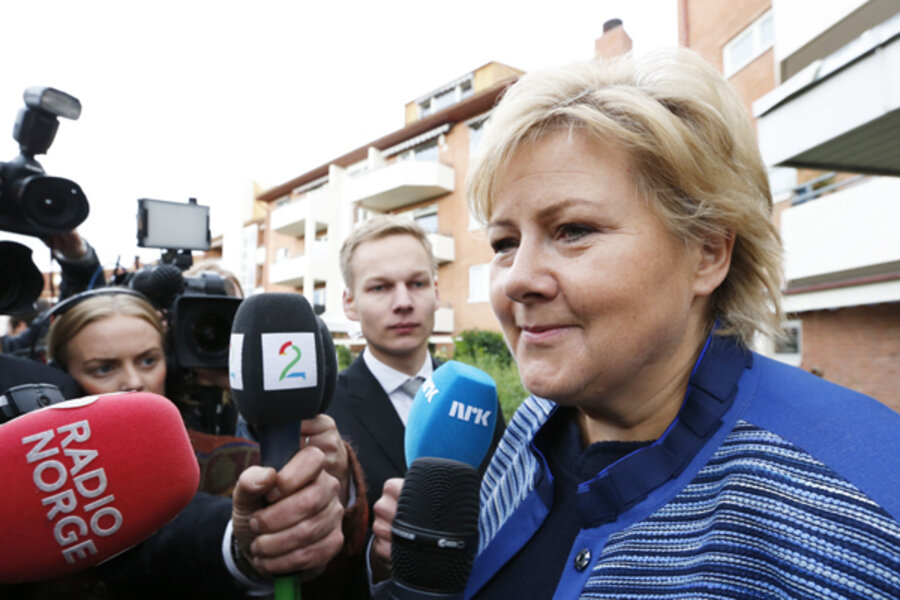In Norway, center-left out, center-right in after election
Loading...
| Oslo, Norway
Norwegian voters weary of eight years under a left-leaning government delivered a landslide victory to a right-leaning coalition, paving the way for the country’s first Conservative prime minister since 1990.
The center-left coalition led by the Labour Party's Jens Stoltenberg received only 72 of the 169 parliamentary seats, paving the way for the Conservative Party's Erna Solberg to become Norway’s next premier.
The ruling Labor party won 30.8 percent of the votes, its second-worst showing since 1927. The Conservatives made a historic comeback from 2009, climbing nearly 10 percentage points to 26.8 percent, the party's biggest improvement between elections ever. Together with the Progress, Christian Democrat, and Liberal parties, the coalition hold a majority with 96 seats. Stoltenberg congratulated Ms. Solberg and announced he would resign after the current government puts forward its budget on October 14.
“Tonight we have to admit disappointment, but we are in no way beaten,” said Stoltenberg on election night, highlighting that Labour is still the largest party in Norway and only 2 percentage points below what it won the election with in 2005.
“Today we are writing history,” Solberg told a cheering group of party supporters at her party's election vigil. “The voters have decided that the Conservatives will once again have a prime minister.”
The Conservatives, who last held the premiership in 1990, are expected to enter coalition negotiations with non-socialist parties. The most likely possibilities are either a minority two-party coalition with the Progress Party or a majority center-right government including the Progress, Christian Democrat and Liberal parties.
Unanswered questions
The values-focused Christian Democrats are reluctant to rule alongside the anti-immigrant Progress Party, however. A third option is minority Conservative government whereby Solberg rules solo with the support of other parties in parliament, but no formal coalition.
“That's the big question and none of us really know what will be the outcome,” said Johannes Bergh, a senior research fellow at the Institute for Social Research in Oslo. “We can’t really rule out anything at this point.”
Though the exact contours of Norway's new government are not yet clear, the political shift to the right will probably not result in any major changes, says Bergh. Both the Labour and Conservative parties agree on a number of issues, such as an expansive welfare state. “We are a liberal Conservative party, we do not make revolutions,” said Solberg at a meeting with international journalists last week. “In a small country like Norway, you have some major areas that you agree on.”
But the Conservatives are promising change. They're expected to increase private sector involvement in road building and health care, lower taxes, further privatize state-owned companies such as Statoil and Telenor, and adopt a more aggressive oil exploration strategy in the waters around the environmentally sensitive Lofoten islands, which had been off limits under the current government.
In foreign policy Solberg expects a “more European focus” as her government will not have the “internal difficulties” over the European Economic Area Agreement that the current government has, she said.
Big spenders?
One question is whether the Progress Party will be able to push through a more expansive budget. The party has expressed a desire to spend beyond a rule set in in 2001 that limits budget spending from the oil rich nation's $750 billion sovereign wealth fund to just 4 percent of its annual return.
The Progress Party would like to spend $2 billion to $5 billion a year on infrastructure projects. Economists fear higher spending could put pressure on Norway's currency, the kroner. “The inflationary pressure, we are aware of that,” said Ketil Solvik-Olsen, Progress Party deputy leader. “But if you make the project so big that you also invite more production capacity to move to Norway, then you very much take care of that problem. But again it has to be profitable investments in roads.”
The Progress Party, whose membership once included terrorist Anders Behring Breivik, would make their debut in government if Solberg includes them in her coalition government. The party came in third and won 29 seats, its third best result.
“I’ve been waiting to say this for a long time,” said Siv Jensen, Progress Party leader as she waited for results. “Bye-bye Jens.”
Another shift in this year’s election is the debut of the Environmental Green Party, in parliament with one seat. The party was successful in stealing votes from the other traditional environmental parties such as the Socialist Left, which barely cleared the 4 percent threshold for securing extra seats.
Rasmus Hansson, Green party’s newly elected parliamentary representative, believes the Socialist Left lost voters after deciding last year to become a more left-wing socialist party focused on labor rather than the environment.
(This story was edited after first posting to remove a reference to the Progress Party as "far right.")







